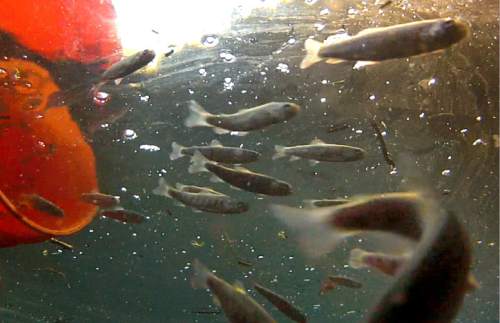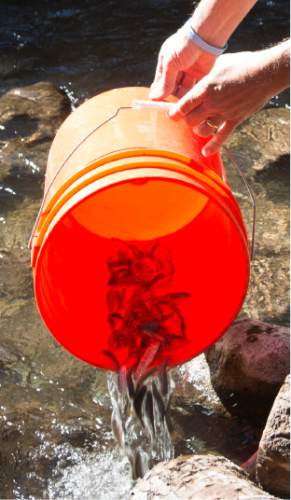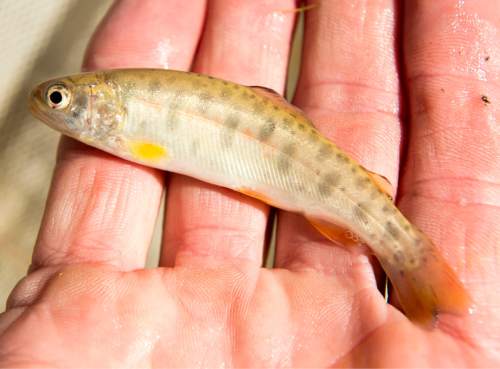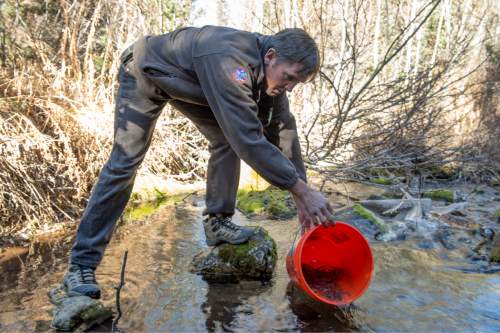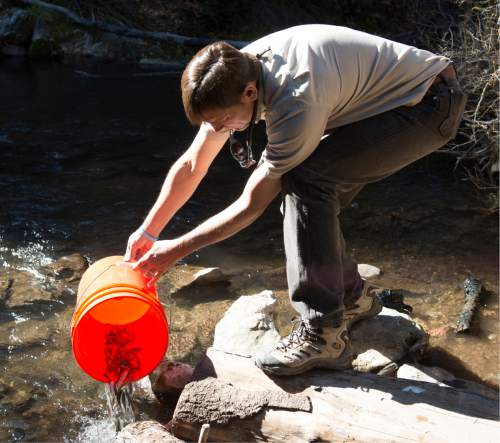This is an archived article that was published on sltrib.com in 2014, and information in the article may be outdated. It is provided only for personal research purposes and may not be reprinted.
Mill Creek Canyon • Small silver flashes mingled with the remaining red and yellow leaves of fall in Mill Creek Wednesday as pure strain Bonneville cutthroat trout returned home after a long sabbatical.
Utah Division of Wildlife Resources biologists and U.S. Forest Service officials released 3,000 cutthroat trout in the upper portions of Mill Creek as part of an effort to restore the native sport fish in waters they swam in when Mormon pioneers arrived.
The pools and eddies at the top of the 9-mile creek just east of the Salt Lake Valley have been void of fish life since the state wildlife agency treated the water with rotenone — a naturally occurring poison that prevents fish from absorbing oxygen into their blood through their gills — twice in the past two years to kill all fish. Nonnative brown trout and rainbow trout had been introduced in Mill Creek over the years by state biologists. In recent years, their efforts have shifted to restoring native sport fish to their home waters.
"People told us before we started the project that they caught cutthroat trout in Mill Creek all the time," said Mike Slater, aquatic biologist for wildlife resource's central region. "There were cutthroat before we treated it, but they had mixed genetically with the rainbows."
The 2- to 3-inch fish released Wednesday came from the eggs and milt of pure-strain Bonneville cutthroat from Mountain Dell and Little Dell reservoirs. The young cutthroat were raised at the Kamas Hatchery, managed by the wildlife division.
The pure part is important. Groups have petitioned to put Bonneville cutthroat on the federal Endangered Species list several times and the U.S. Fish and Wildlife Service has concluded a listing is not warranted.
"The fish need to be a pure Bonneville cutthroat in order for us to get credit toward keeping them from being listed. They won't include mixed fish in existing populations when they consider future petitions," Slater said.
Over several years, wildlife managers sectioned off the creek and set a treatment schedule using existing barriers that would prevent fish from swimming upstream into waters already treated.
The upper portion of the creek was treated with a fish-killing treatment this summer to make sure no fish had escaped the first application in 2013. When no fish turned up, the plan to reintroduce the native trout moved forward.
A middle portion of Mill Creek was treated for the first time this past summer and will get another dose of rotenone next summer before Bonneville cutthroat are introduced in that section of the creek.
The lowest part of the stream will be treated to the mouth of the canyon near the toll booth in the summer of 2015 and get a second treatment in 2016.
If samples come back clean of any fish, the entire stretch of Mill Creek in the canyon will have nothing but native trout swimming in it by the fall of 2016.
Paul Cowley, fish and wildlife program manager for the Uinta-Wasatch-Cache National Forest, said partners, volunteers and the public are helping to create a smooth reintroduction process and cover the cost.
Part of the project involved replacing undersized culverts in the canyon and revegetation.
"The new culverts replaced last month will help when we have peak flows and work better for fish passage," Cowley said. "They are close to 13 feet wide, allowing debris to pass through during flooding and prevent us from losing road surface when the culverts become plugged."
Even the small lake on Camp Tracy in Mill Creek Canyon, owned by the Boy Scouts, will be treated and stocked with native cutthroat trout.
Members of the Stonefly Society, the Salt Lake Chapter of Trout Unlimited, have volunteered during each of the treatments to remove dead fish and assist in any way possible. While picking up fish, volunteers also collected trash in and along the creek.
"The Mill Creek restoration project has been, and will be, our flagship conservation project until it is done," said Layne Read, president of the Stonefly Society.
Trout Unlimited national provided $5,000 through the Embrace a Stream program. Volunteers from Stonefly Society and other Trout Unlimited chapters have turned in countless hours of work.
"Restoring Mill Creek to a vital, healthy and native ecosystem is important to everybody," Read said. "Like most streams across the Wasatch, Mill Creek will become an important watershed. It is just the nature of population growth.
"As an angler, I love the fact there is one specific stream I can get to in a reasonable time and experience fishing for a native species with my grandchildren," he said.
While not reintroduced Wednesday, Slater said, other native fish thought to have been in Mill Creek when settlers arrived will eventually be released into the creek. Once proven disease-free, sculpin, dace and mountain sucker will be caught in other Wasatch Front creeks and moved to Mill Creek.
Utah wildlife officials have been working to restore native cutthroat populations — including Bonneville, Colorado River and Yellowstone — across the state for years.
The effort at Mill Creek, so close to the state capital and major population centers, makes this restoration project a little different.
"We have projects trying to restore cutthroat to their historic range all over the state," Slater said. "With this one so close to the city, we really could not afford any kind of a failure or problems because it could jeopardize what we are doing across the state. This is a wonderful chance for us to educate the public and, more than anything, to clear up misconceptions and misunderstandings."
Twitter: @BrettPrettyman


